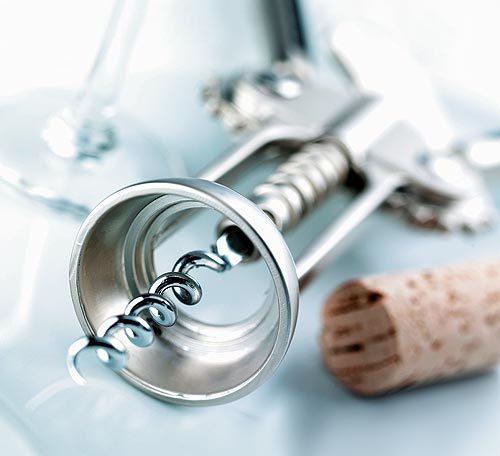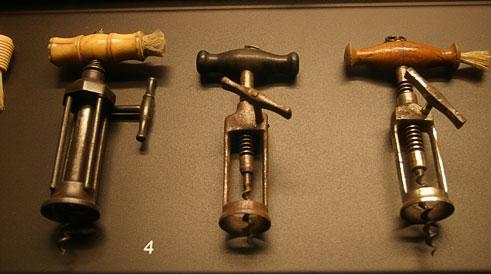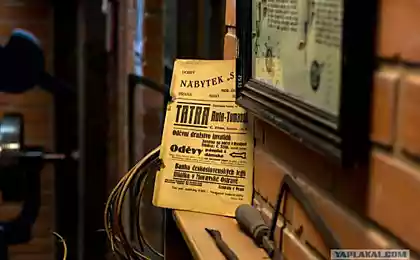778
The history of the corkscrew
In the life of every human being had a situation when I buy a bottle of good wine and a corkscrew on hand not proved ...
Cork from the bark of the cork oak has always been a friend for wine lovers ... and the enemy. No cork from any other material not suitable as an ideal for sealing wine bottles like this: it does not attach blame no taste or smell, and for a long time remain flexible. But cork is fiendishly difficult to extract from the bottle! And it has always been from the very first day of its use until the end of the 18th century.
9 ph via horror1017

Before there were traffic jams, wine served at the table in jars, in which it was poured directly from the barrels. Later, when the wine is stored in steel bottles, cork inserted in such a way that part of it peeking out - for it could grab his hand and pull. But when the winegrowers began to push the plug deep into the neck of the bottle, there is an urgent need to find a convenient way to retrieve it.
That just did not take wishing to drink! Shaking the bottle cap poked with a knife, tried to push it inside the bottle, some even fought off the neck. Sometimes trying to get to the end safely wine, sometimes not, but all parties involved assimilated one important lesson - without a corkscrew for a bottle is better not to take.
Unfortunately, the name of the inventor and the exact date of the birth of a unique device history is not retained.
Rather, it made an Englishman in the first half of the XVIII century - soon after the birth of the "modern" plug. The fact that first the latter was similar to the fungus (as champagne). The massive device from the bark of cork oak cost too much, in order to save her hat "cut" and left leg only. And last I had somehow taken out of the bottle, that's come up with a corkscrew. The first patent for his invention was a member of the British cabinet minister Samuel Henshall, and it happened only in 1795, when a similar T-shaped weapon was used for a long time. Since there were more than 350 for the various devices. However, most units have a common principle of action - they have a helix piercing plug and leverage, helping to extract it from the bottle.

Improving Samuel Henshallya consisted soldered corkscrew metal circle: the circle pursued two goals: first, he did not allow screw corkscrew too deep, and secondly, resting in a traffic jam, he made scroll it with a corkscrew, thus "otkleivaya "plug from the wall bottle neck, allowing easier extraction.
More inquisitive minds, meanwhile, tried to use the legacy of Archimedes: what was needed once the lever that engineers tried to give compassionate. I do not Archimedes, as he hardly felt the need for a good corkscrew, because obviously did not open his own wine, and weaker, or effeminate, or sophisticated individuals. For example, in 1802 the Englishman Edward Thomason corkscrew patented the first double action: thus dividing the process into several stages managed to facilitate taking out the plug. The lateral arrangement of the lever to display the cork is also patented an Englishman by the name of Lund in 1855.

The famous wine critic Hugh Johnson in his book "History of Wine" leads the first description of a corkscrew, made in 1681: it is "steel worm, used for pulling corks out of bottles." Then he called the "bottle-screw". It is believed that the prototype of this necessary every connoisseur of wines served twisted spiral tool auger, with which extracted a bullet from a pistol, who gave a misfire.

Double Wishbone first spin, the same design, as you can seen in the modern shops, patented again Englishman Healey in 1888. Oh, one can see that sophisticated people: a drink - so tasteful! However, it is proof of a successful design is the ubiquity of this model in everyday life.
The Americans, however, did not lose time in vain. Already in 1883, William Bennett has patented an improved version Henshalla spin: instead he proposed to burn on the disc to spin a special cap. The idea was not as silly as it might seem at first glance: the twisting corkscrew to lock the cap rests in the very bottleneck, so with continued movement begins to lift the stopper up, presumably until such time as the plug entirely be in the cap.
Another of the interesting designs should pay attention to the "corkscrew waiter" - an invention patented by the German Carl Veynke also in 1883. The idea is simple to ugliness: Corkscrew screwed into the cork, then, emphasizing the short end of the corkscrew into the neck of the bottle, the cork is very easy climbs when climbing a long lever. Sometimes on the short end do several steps to fight unconventionally long traffic jams. This design is also very popular these days as restaurants (waiters do wonders with this corkscrew), and in the form of pocket-folding versions.

And finally, in 1979, Herbert Allen has created a corkscrew Screwpull (Skryupul). He proved that with conventional corkscrews, spent too much effort. Table based model, invented by Allen, lay down a simple principle, which consists in the fact that the plug can and should be removed from the bottle without stress, injury or related embarrassing situations.
Screwpull quickly gaining popularity. The product has a beautiful design and is firmly fixed on the neck of the bottle. Corkscrew with teflon coating is easily screwed into the plug, which is then easily comes out of the bottle - you do not have to pull it.
Allen went a step further and developed the Pocket model. Then he created a lever model - essentially an innovative corkscrew in a long line of models who were born since the day when the first gunsmith put retriever service charges on helpless stopper.
Genius model requires only wine lovers is easy to press the lever, and then lift it. While a pair of handles securely hold the bottles in place, Teflon corkscrew readily enters into the cork. Made from the same material as that used in fighter Stealth, Ryzhachnaya model Screwpull combines design, functionality and convenience, as no other spin until now.
Today, some of the early models of corkscrews sold at auction for hundreds of dollars. Their price - a tribute to their uniqueness, as all indicators they lose corkscrews Screwpull.
Mr. Allen began working on Screwpull in 1975. The impetus for the invention were the complaints of his wife, for which opening wine bottles accompanied by constant anguish and frustration. Having tried various models of corkscrews, she finally put before her husband engineering task - to create a spin that would always, without effort and failure, removed the cork from the bottle. Mr. Allen went to work in his studio, located in the basement of the house, and in 1979 Screwpull was ready.

There is another device for removing corks from bottles, which is hardly even a corkscrew. Spirals in it, but there is a needle with a pump or gas cartridges. "Syringe" pierces the stopper, a man pumps air into the bottle. Alternatively, just click on the button - and gas is supplied from a container. As a result, the pressure rises and the cork comes out. Experts believe that such an instrument could not think of a true connoisseur of wine. The fact that high pressure causes stress in the beverage and alters its flavor. This is especially true of expensive liquor soaked.
By the way, a few resourceful Americans have perfected the idea: selling versions of the corkscrew equipped with a can of compressed carbon dioxide. It is true there may suddenly get the real effect of champagne, which also includes the risk of getting pop-up stopper in the eye ...

A great lover of Burgundy, Napoleon Bonaparte, demanded that the ammunition of every soldier in his army was certainly ... a corkscrew. It may seem strange, but the habitual thing in each house is also a collector's interest.
To collect corkscrews themselves without realizing it, begin to connoisseurs of good wine. After all, "the wine will not come to light until the cork with the corkscrew does not sin", as the old British toast.
Dyuven Bernard, one of the first French collectors, first bought the old corkscrew (also known as a corkscrew), because it seemed vulgar discover excellent vintage wine ordinary piece of wood with a spiral. For the first corkscrew Frenchman followed by a second, and then - the third, and now in the collection Dyuvena about 250 copies, some of which are rare examples of the late XVII century.
Depending on the material, structure, age and "pedigree" antique corkscrew price can range from a few dollars to tens of thousands. The record is considered to be the price of just over $ 31 thousand., Paid for a tailspin in 1842 at an auction Christie`s. An electronic auction e-Bay has a spin of the XIX century was sold for a more modest, but still impressive sum of $ 13 thousand. 550. engraver carefully finished more than a hundred years ago, a corkscrew-shaped fish on a Paris auction offered for 15-20 thousand. Euro .

Corkscrew - chief guest of any holiday, be it New Year, a birthday or anniversary of the company. It is from this conventional, firmly entered into the everyday life of the subject depends on "the success of the entire enterprise." Catastrophe like no spin on the holiday, and then, really, "half my kingdom for a horse" ... in the sense of a tailspin.

Source:
Cork from the bark of the cork oak has always been a friend for wine lovers ... and the enemy. No cork from any other material not suitable as an ideal for sealing wine bottles like this: it does not attach blame no taste or smell, and for a long time remain flexible. But cork is fiendishly difficult to extract from the bottle! And it has always been from the very first day of its use until the end of the 18th century.
9 ph via horror1017

Before there were traffic jams, wine served at the table in jars, in which it was poured directly from the barrels. Later, when the wine is stored in steel bottles, cork inserted in such a way that part of it peeking out - for it could grab his hand and pull. But when the winegrowers began to push the plug deep into the neck of the bottle, there is an urgent need to find a convenient way to retrieve it.
That just did not take wishing to drink! Shaking the bottle cap poked with a knife, tried to push it inside the bottle, some even fought off the neck. Sometimes trying to get to the end safely wine, sometimes not, but all parties involved assimilated one important lesson - without a corkscrew for a bottle is better not to take.
Unfortunately, the name of the inventor and the exact date of the birth of a unique device history is not retained.
Rather, it made an Englishman in the first half of the XVIII century - soon after the birth of the "modern" plug. The fact that first the latter was similar to the fungus (as champagne). The massive device from the bark of cork oak cost too much, in order to save her hat "cut" and left leg only. And last I had somehow taken out of the bottle, that's come up with a corkscrew. The first patent for his invention was a member of the British cabinet minister Samuel Henshall, and it happened only in 1795, when a similar T-shaped weapon was used for a long time. Since there were more than 350 for the various devices. However, most units have a common principle of action - they have a helix piercing plug and leverage, helping to extract it from the bottle.

Improving Samuel Henshallya consisted soldered corkscrew metal circle: the circle pursued two goals: first, he did not allow screw corkscrew too deep, and secondly, resting in a traffic jam, he made scroll it with a corkscrew, thus "otkleivaya "plug from the wall bottle neck, allowing easier extraction.
More inquisitive minds, meanwhile, tried to use the legacy of Archimedes: what was needed once the lever that engineers tried to give compassionate. I do not Archimedes, as he hardly felt the need for a good corkscrew, because obviously did not open his own wine, and weaker, or effeminate, or sophisticated individuals. For example, in 1802 the Englishman Edward Thomason corkscrew patented the first double action: thus dividing the process into several stages managed to facilitate taking out the plug. The lateral arrangement of the lever to display the cork is also patented an Englishman by the name of Lund in 1855.

The famous wine critic Hugh Johnson in his book "History of Wine" leads the first description of a corkscrew, made in 1681: it is "steel worm, used for pulling corks out of bottles." Then he called the "bottle-screw". It is believed that the prototype of this necessary every connoisseur of wines served twisted spiral tool auger, with which extracted a bullet from a pistol, who gave a misfire.

Double Wishbone first spin, the same design, as you can seen in the modern shops, patented again Englishman Healey in 1888. Oh, one can see that sophisticated people: a drink - so tasteful! However, it is proof of a successful design is the ubiquity of this model in everyday life.
The Americans, however, did not lose time in vain. Already in 1883, William Bennett has patented an improved version Henshalla spin: instead he proposed to burn on the disc to spin a special cap. The idea was not as silly as it might seem at first glance: the twisting corkscrew to lock the cap rests in the very bottleneck, so with continued movement begins to lift the stopper up, presumably until such time as the plug entirely be in the cap.
Another of the interesting designs should pay attention to the "corkscrew waiter" - an invention patented by the German Carl Veynke also in 1883. The idea is simple to ugliness: Corkscrew screwed into the cork, then, emphasizing the short end of the corkscrew into the neck of the bottle, the cork is very easy climbs when climbing a long lever. Sometimes on the short end do several steps to fight unconventionally long traffic jams. This design is also very popular these days as restaurants (waiters do wonders with this corkscrew), and in the form of pocket-folding versions.

And finally, in 1979, Herbert Allen has created a corkscrew Screwpull (Skryupul). He proved that with conventional corkscrews, spent too much effort. Table based model, invented by Allen, lay down a simple principle, which consists in the fact that the plug can and should be removed from the bottle without stress, injury or related embarrassing situations.
Screwpull quickly gaining popularity. The product has a beautiful design and is firmly fixed on the neck of the bottle. Corkscrew with teflon coating is easily screwed into the plug, which is then easily comes out of the bottle - you do not have to pull it.
Allen went a step further and developed the Pocket model. Then he created a lever model - essentially an innovative corkscrew in a long line of models who were born since the day when the first gunsmith put retriever service charges on helpless stopper.
Genius model requires only wine lovers is easy to press the lever, and then lift it. While a pair of handles securely hold the bottles in place, Teflon corkscrew readily enters into the cork. Made from the same material as that used in fighter Stealth, Ryzhachnaya model Screwpull combines design, functionality and convenience, as no other spin until now.
Today, some of the early models of corkscrews sold at auction for hundreds of dollars. Their price - a tribute to their uniqueness, as all indicators they lose corkscrews Screwpull.
Mr. Allen began working on Screwpull in 1975. The impetus for the invention were the complaints of his wife, for which opening wine bottles accompanied by constant anguish and frustration. Having tried various models of corkscrews, she finally put before her husband engineering task - to create a spin that would always, without effort and failure, removed the cork from the bottle. Mr. Allen went to work in his studio, located in the basement of the house, and in 1979 Screwpull was ready.

There is another device for removing corks from bottles, which is hardly even a corkscrew. Spirals in it, but there is a needle with a pump or gas cartridges. "Syringe" pierces the stopper, a man pumps air into the bottle. Alternatively, just click on the button - and gas is supplied from a container. As a result, the pressure rises and the cork comes out. Experts believe that such an instrument could not think of a true connoisseur of wine. The fact that high pressure causes stress in the beverage and alters its flavor. This is especially true of expensive liquor soaked.
By the way, a few resourceful Americans have perfected the idea: selling versions of the corkscrew equipped with a can of compressed carbon dioxide. It is true there may suddenly get the real effect of champagne, which also includes the risk of getting pop-up stopper in the eye ...

A great lover of Burgundy, Napoleon Bonaparte, demanded that the ammunition of every soldier in his army was certainly ... a corkscrew. It may seem strange, but the habitual thing in each house is also a collector's interest.
To collect corkscrews themselves without realizing it, begin to connoisseurs of good wine. After all, "the wine will not come to light until the cork with the corkscrew does not sin", as the old British toast.
Dyuven Bernard, one of the first French collectors, first bought the old corkscrew (also known as a corkscrew), because it seemed vulgar discover excellent vintage wine ordinary piece of wood with a spiral. For the first corkscrew Frenchman followed by a second, and then - the third, and now in the collection Dyuvena about 250 copies, some of which are rare examples of the late XVII century.
Depending on the material, structure, age and "pedigree" antique corkscrew price can range from a few dollars to tens of thousands. The record is considered to be the price of just over $ 31 thousand., Paid for a tailspin in 1842 at an auction Christie`s. An electronic auction e-Bay has a spin of the XIX century was sold for a more modest, but still impressive sum of $ 13 thousand. 550. engraver carefully finished more than a hundred years ago, a corkscrew-shaped fish on a Paris auction offered for 15-20 thousand. Euro .

Corkscrew - chief guest of any holiday, be it New Year, a birthday or anniversary of the company. It is from this conventional, firmly entered into the everyday life of the subject depends on "the success of the entire enterprise." Catastrophe like no spin on the holiday, and then, really, "half my kingdom for a horse" ... in the sense of a tailspin.

Source:























